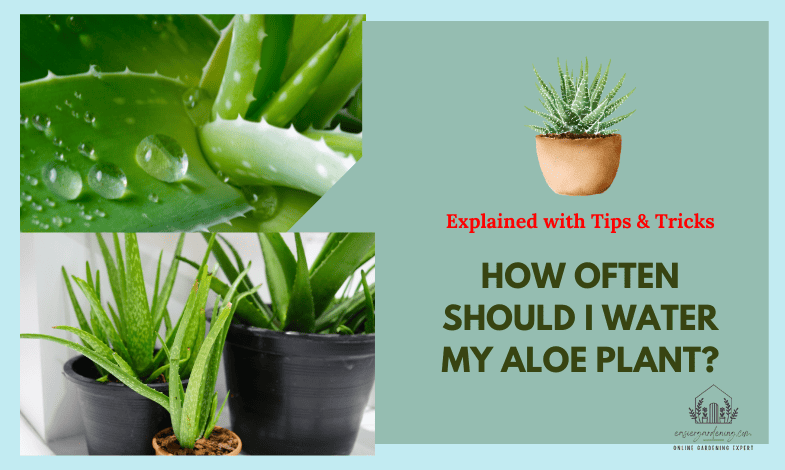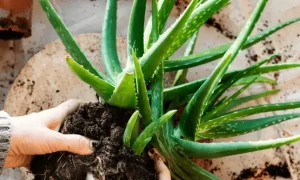Care for Aloe Plant: Proper Watering, Fertilizing & Pruning: The Aloe plant can be used in many ways as a decorative and medicinal plant. Many people use the Aloe plant as a medicinal or green plant. But how do you care for your aloe plant properly? However, you need some background knowledge to ensure that the plant grows healthy and strong when caring for it. Read everything about watering, fertilizing, and pruning the succulent with us. So, if you have any questions in mind like “how often should I water my aloe plant” or “how to take care of aloe plant,” don’t be worried. This article tells you how to care for the aloe plant properly.
Contents
- Fertilizing Aloe Plant
- How Often Should I Water my Aloe Plant?
- Aloe Plant Care: Watering Aloe Plant
- Pruning the Aloe Plant
- Aloe Plant Turns Brown: What to Do?
- Final Thoughts: How Often Should I Water my Aloe Plant?
- Where should I keep my aloe plant?
- Should I cut off the brown part of my aloe plant?
- How often should aloe plants be watered?
- Do aloe plants need direct sunlight?
Fertilizing Aloe Plant
Read more about How much water per gallon of soil?
Fertilizing aloe plants is not easy. Aloe plant originally comes from the desert-like, hot regions of the Arabian Peninsula. There, the plant’s nutrient supply is minimal. It, therefore, naturally needs very little fertilizer. Nevertheless, occasional fertilization of the aloe plant is beneficial, primarily if used as a medicinal plant. It then recovers better from pruning and produces strong, healthy leaves with plenty of gel.
Therefore, it is good to fertilize the aloe plant approximately every two weeks via irrigation water during the growing season. In this way, the nutrients essential for the plant are better distributed in the soil solution, are available more quickly, and ensure healthy and vigorous growth. An organic indoor and green plant fertilizer is suitable for this purpose, for example. In addition to a balanced nutrient composition and a resource-saving, lower phosphorus content, this type of fertilizer has additional microorganisms to utilize the substrate’s nutrients better. Because of its completely organic and animal-free production, it also protects the environment and the climate.
Learn more about Best Soil For Aloe Vera
Important: Immediately after repotting, you do not need to fertilize the aloe plant, because the nutrient reserves of the fresh soil are still sufficient to supply the plant. Fertilizing the plant during the winter dormancy between October and April is unnecessary.
How Often Should I Water my Aloe Plant?
Aloe Plant Care: Watering Aloe Plant
For your questions like “how often should I water my aloe plant,” this is the part for you. A succulent aloe plant can store water in its leaves and tolerate drought for extended periods. Therefore, compared to many other houseplants, it rarely needs water and is sensitive to waterlogging. Nevertheless, the substrate should be permanently moist and not dry out completely. If the aloe plant is watered without allowing the water to drain away, water saturation will inhibit soil aeration, and root rot may occur.
It is also important not to let the water run over the leaves when watering for rosette-forming plants such as aloe plants. Otherwise, water can back up in the heart of the rosette – this encourages fungal growth and can cause the plant to start rotting. Low-calcium water, such as rainwater or mineral water, is best for aloe plants.
But how often should you water the aloe plant? Usually, it is sufficient to water it once a week. The right time can be easily determined by finger testing: When the soil’s surface is dry, you can water again.
Warning: Increased caution is required with young plants because the leaves cannot yet store as much water as older plants. Therefore, they should be watered more frequently but with smaller amounts of water.
Since the aloe plant hibernates our latitudes because of the cooler climate, it is essential to adjust the watering rhythm of the plant. It should occasionally be watered in its cool winter quarters so that the root ball does not dry out. The risk of root rot from too much wetness is higher during the winter, as the aloe plant does not absorb as much water as it does during the growing season.
Pruning the Aloe Plant
Maintenance pruning is not necessary for the aloe plant. If you want to keep your plant in shape, so it doesn’t grow too tall or sprawling, you can cut off the outer, old leaves if necessary. Also, diseased or damaged leaves should permanently be removed.
If you want to use it as a medicinal plant, you should regularly harvest the outer leaves of the aloe plant to use the gel. Plants older than three years are especially suitable for this purpose – their leaves are larger and more vital than those of younger plants. They have more gel, recover better from the harvest and form new leaves faster.
Aloe Plant Turns Brown: What to Do?
Sometimes the aloe plant leaves can turn brown, grayish-purple, or pale. It can be due to various reasons: There is no need to worry if the outer, older leaves turn brown. The plant continues to develop, shedding the older leaves and forming new ones inside.
Sometimes discoloration of the leaves also occurs immediately after repotting – this is also not a problem. The aloe plant needs some time to grow in the new substrate; then the discoloration disappears all by itself.
Note: If the Aloe plant has not been repoted for a long time, the old substrate may lack nutrients, so the leaves turn brown. Repotting in time will then supply the plant with nutrients again.
A reddish to brownish coloration may be a reaction to too much direct sun, as this allows the aloe plant to protect itself. If the leaf tips also become dry, it is time to move the aloe plant to a less sunny location. The leaves will then already return to their vibrant green color after a short time.
It is more problematic if none of the previously described problems can be identified and corrected. Especially if the inner, younger leaves also turn brown or yellow, this can indicate too much water. A succulent aloe plant can store large amounts of water in its leaves but tolerates waterlogging very poorly. At the latest, when the aloe plant leaves become soft when pressed lightly between the fingers, stagnant water should be poured away, and watering stopped entirely for one to two weeks. Discolored, delicate leaves can be cut off and discarded, as they provide a good target for fungi.
Caution: If overwatered, the leaves may turn brown and soft. Watering should be stopped completely for 1 to 2 weeks to allow the root ball to dry out. Caution: risk of rot and fungal attack.
Learn more about How often should I water my garden?
Final Thoughts: How Often Should I Water my Aloe Plant?
Aloe has gained a lot of popularity in recent years. The term is particularly associated with the plant species Aloe vera and its health-promoting properties. The aloe leaves contain a gel-like plant juice, which is highly valued in natural medicine. This medicinal plant is mentioned in Greek writings as early as 400 years BC and has been documented in Chinese medicine since the 11th century. The plant enjoys increasing popularity due to its natural healing powers and low maintenance requirements. However, like every other plant, it needs to be taken care of. This article has tried to answer all questions regarding this plant-like “how often should I water my aloe plant” or “how to take care of aloe plant” in detail. So be sure to take care of your aloe plant.
Frequently Asked Questions
Where should I keep my aloe plant?
Keeping the aloe vera plant near a sunny window is recommended to receive an adequate amount of indirect sunlight. Read more about What kind of pot is best for the Aloe Plant?
Should I cut off the brown part of my aloe plant?
Yes, it would help if you cut off any leaf tips that have turned pinkish or brown. It will help the plant stay green and healthy.
How often should aloe plants be watered?
Aloe vera plants should be watered deeply but infrequently. Make sure you give the soil enough time to dry for at least 1 to 2 inches deep. As a general rule, watering every three weeks is safe during the winter.
Do aloe plants need direct sunlight?
Yes, your aloe plants must receive a minimum of six hours of direct sunlight every day.



